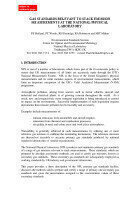Air Monitoring
GAS STANDARDS RELEVANT TO STACK EMISSION MEASUREMENTS AT THE NATIONAL PHYSICAL LABORATORY
Oct 06 2014
Author: PE Holland, PT Woods, RH Partridge, RA Robinson and MJT Milton on behalf of CEM
INTRODUCTION
NPL is one of a number of laboratories which forms part of the Governments policy to ensure that UK measurements of all kinds are accurately made through the DTI’s National Measurement System. NPL is the focus of the United Kingdom’s physical measurements and its remit includes aspects of environmental measurements, which form an important component of the UK’s Valid Analytical Measurement (VAM) programme.
Atmospheric pollution, arising from sources such as motor vehicles, aircraft and industrial and electrical plants, is of growing concern throughout the world. As a result, new and progressively more stringent legislation is being introduced to control its impact on the environment. Successful implementation of such legislation requires instruments that measure pollution levels traceably and accurately.
Examples include measurements of:
- exhaust emissions from automobile and aircraft engines;
- emissions from chemical and combustion processes;
- air quality in rural and urban areas and work place atmospheres.
Traceability is generally achieved in such measurements by utilizing one or more reference gas mixtures to calibrate the monitoring instruments. The reference mixtures are themselves traceable to accurate primary gas standards produced by national standards laboratories or similar organisations.
The National Physical Laboratory (NPL) produces and maintains primary gas standards of a range of gas mixtures relevant to stack measurements. These standards, which are prepared by absolute gravimetric methods, are used to certify gas mixtures, known as secondary gas standards. These secondary gas standards are subsequently employed as working standards by UK industry and government laboratories.
This paper provides a short description of the NPL primary gas standards facility, discusses the methods used to prepare and certify a range of primary and secondary gas standards and gives the uncertainties assigned to the concentration values of these secondary standards.
Some of these secondary standards have been used as part of a proficiency testing programme within the STA. Eighteen participants were involved in a ‘round robin’ exercise measuring three gases (carbon monoxide, nitric oxide and sulphur dioxide) at emission levels. The results of this pilot proficiency testing programme will be presented.
Digital Edition
AET 28.2 April/May 2024
May 2024
Business News - Teledyne Marine expands with the acquisition of Valeport - Signal partners with gas analysis experts in Korea Air Monitoring - Continuous Fine Particulate Emission Monitor...
View all digital editions
Events
Jul 30 2024 Jakarta, Indonesia
China Energy Summit & Exhibition
Jul 31 2024 Beijing, China
2024 Beijing International Coal & Mining Exhibition
Aug 07 2024 Beijing, China
IWA World Water Congress & Exhibition
Aug 11 2024 Toronto, Canada
Aug 25 2024 Stockholm, Sweden and online






.jpg)








